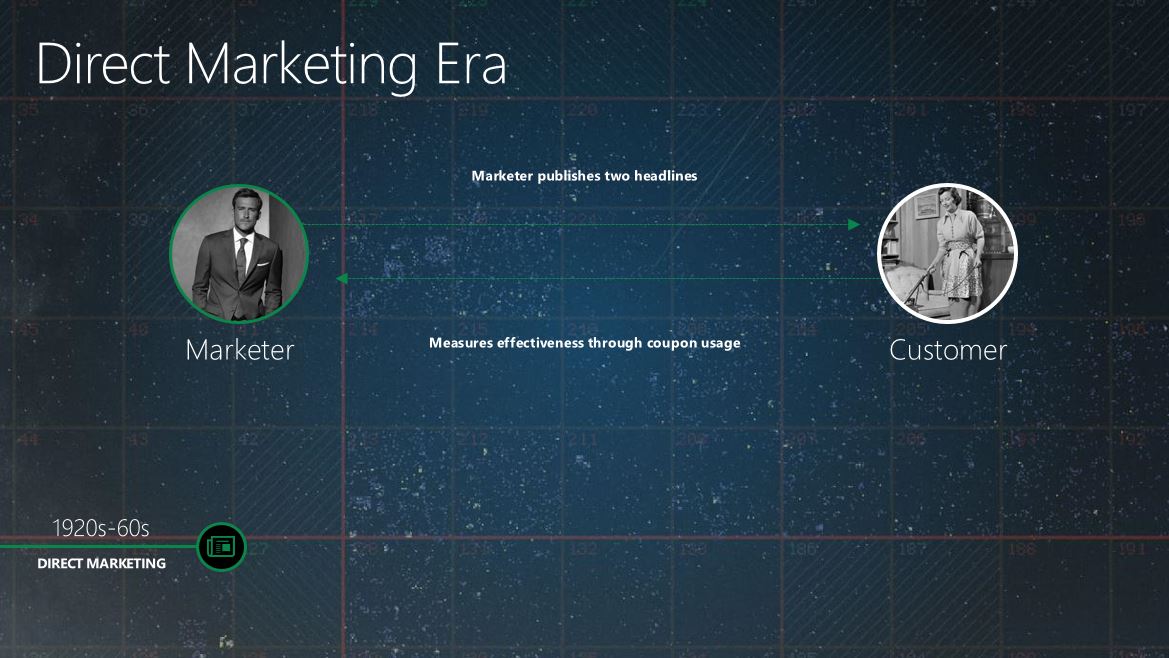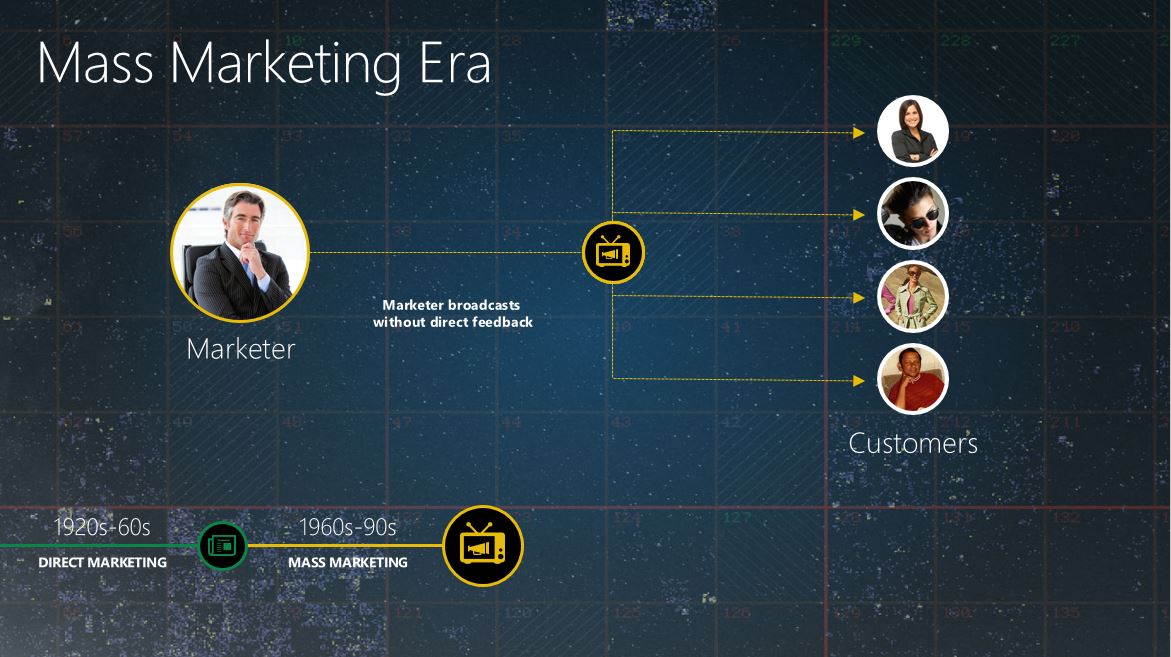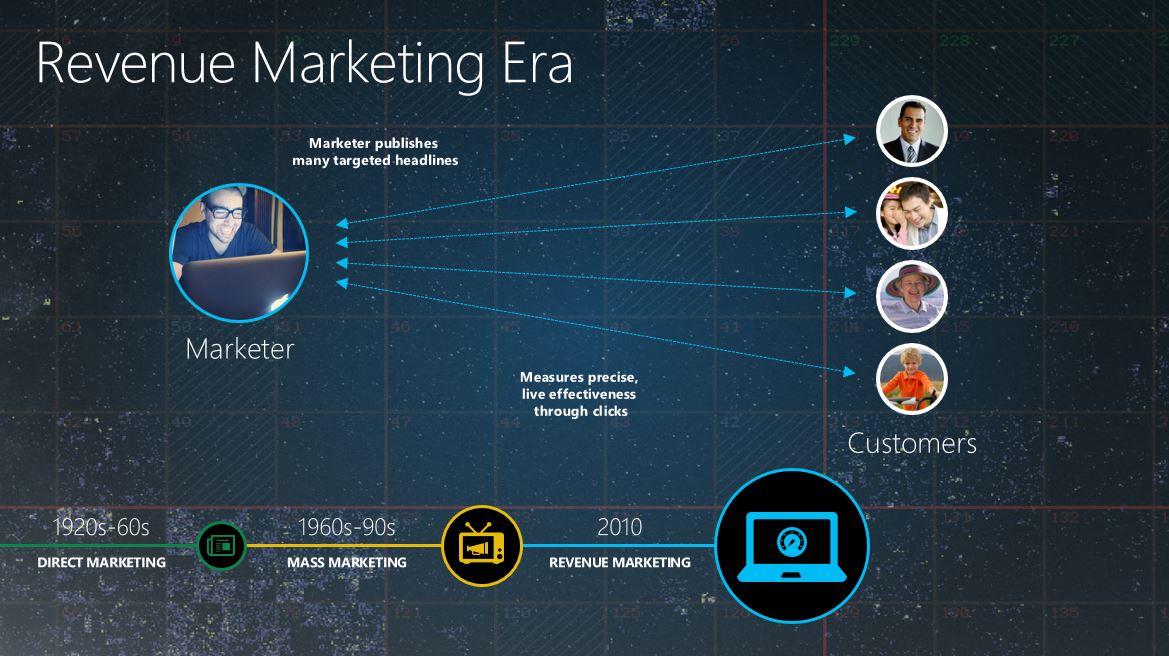The Three Eras of Marketing — Welcome to the “Revenue Marketing” Era
In most industries, there are “three windows” on your device — your mail client; your Web browser; and your LOB app. Except for marketers — for years we have had to live in a patchwork world with multiple LOB apps and systems.
Not anymore … at least, not for long. Companies such as Marketo; Eloqua (owned by Oracle); and Microsoft (Dynamics Marketing) are finally taking marketing professionals seriously, and creating LOB apps for the marketing discipline. Suddenly, it’s a great time to be a marketer!
Why the sudden burst in enthusiasm for marketers? Is it our dashing good looks and tastefully trimmed sideburns? Or … is it something else?
What’s going on is nothing short of a massive sea change in the marketing discipline — and a move to a more professional and measured profession.
DIRECT MARKETING ERA (1910 to 1960)
The marketing profession is actually a relatively young discipline. While the industry technically started in 1878 with J. Walter Thompson’s “Copernican Shift” to centrally buy newspaper ads for multiple manufacturers at no cost to the manufacturer — but with a 15% spiff from the newspapers (“commission”); the industry really started in 1910 with Albert Lasker, Claude Hopkins, and John E. Kennedy who all worked together at the Chicago-based advertising agency Lord & Thomas, and were the first to give away creative services for free on the theory that more effective ads would lead their clients to buy more advertising. They operated on the principle that advertising was “… salesmanship in print”. The truth of this hypothesis made all three men very successful, and in the case of Albert Lasker, one of the wealthiest individuals in the United States. There is an excellent book on the history of Lord & Thomas called “The Man Who Sold America”, available on Amazon: Link
This first age of advertising, which was primarily print focused, was the “Direct Marketing Era”. It was a time of mail and print ads with coupons … coupons which were coded and split run so that the advertisers could test headlines and creative executions against each other:

For an excellent description of how this worked at the peak of the art in the 1950s, read any of John Caples (former VP BBDO, and God of all advertising geeks everywhere) books:
- How to Make Your Advertising Make Money by John Caples: Link
- Tested Advertising Methods by John Caples: Link
- Making Ads Pay: Timeless Tips for Successful Copywriting by John Caples: Link
MASS MARKETING ERA (1960 to 2000)
The dawn of the 1960s saw the birth of mass TV and mass communications — and the end of split run coupon testing. The profession entered a stage of “shifting perception” and “creating awareness”, and the tools of effectiveness measurement became research based. This was an amazing time in marketing because the discipline had influence and impact like never before. However, it also spawned a lot of bad habits, and the lack of day-to-day accountability to revenue created a whole generation of marketers who associated *activity* with *results*, as opposed to associating *sales* to *results*. It also marked the end of the professionalism of the discipline, and anyone became a “marketer” simply by entering the industry — almost like a first-year biology student being recognized as a “doctor”:

REVENUE MARKETING ERA (2000 to Now)
As the Web increased its penetration to threshold levels — and as tools like tagging; cookies; and re-targeting came into vogue — we suddenly found ourselves at an interesting crossroad: The measurement and sales accountability of the Direct Marketing Era had met the reach and pervasiveness of the Mass Marketing Era. Welcome to the Revenue Marketing Era — a new dawn of marketing professionalism and accountability:
The tools required to manage complex highly-scaled campaigns in this Revenue Marketing model are the tools of Marketing Automation.
Marketing Automation is a technology that enables marketers to use marketing techniques that improve the quality of leads handed to sales. It enables marketers to track and align customer behavior with purchase cycle stage, and use this information to provide relevant responses, such as content; calls to action; and offers.
The term “Marketing Automation” is widely misunderstood, with a common misinterpretation being that it is a term that applies to all marketing information systems. In fact, “Marketing Automation” is a very specific term that refers to a process of “Revenue Marketing” whereby the marketing function focuses on creating “MQLs”, or “Marketing Qualified Leads”; and the quality of the MQL output is measured by “SALs”, or “Sales Accepted Leads”. The process of creating an MQL is a form of gamification for the marketers themselves because leads do not become MQLs until they have achieved a minimum threshold “Lead Score”, which will typically require a multiple of interactions to be achieved. The accumulation of marketing “touches” adds to a prospect’s Lead Score until (based on organizational experience) the Lead Score is sufficiently high that the prospect is qualified as a genuine sales lead and transferred to the Sales CRM system. Executed correctly, this creates a system wherein Marketing generates fewer, higher quality leads and Sales trusts the leads to convert, resulting in a higher Lead Acceptance rate and generally higher close rates for the organization.
There is a series of publications from Marketo called the “Marketo Definitive Guides”, and reading these will give you an excellent working understanding of Marketing Automation. You can download the Marketo Definitive Guides here: http://www.marketo.com/definitive-guides
I also recommend the book called Manufacturing Demand, which is a free download. It is written by David Lewis, who is an expert on Marketing Automation, and an excellent resource for lead management and aligning marketing & sales; this is required reading on my team.

